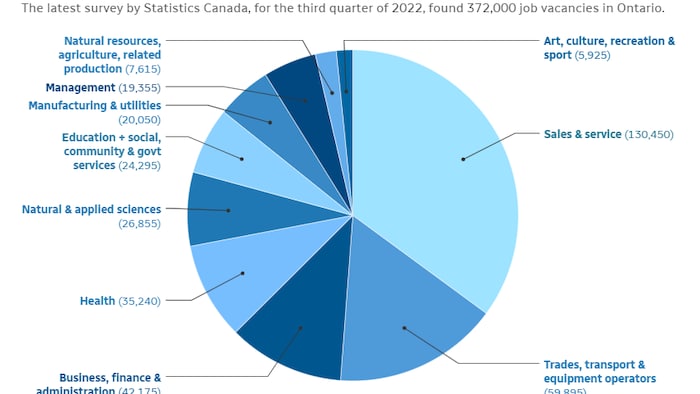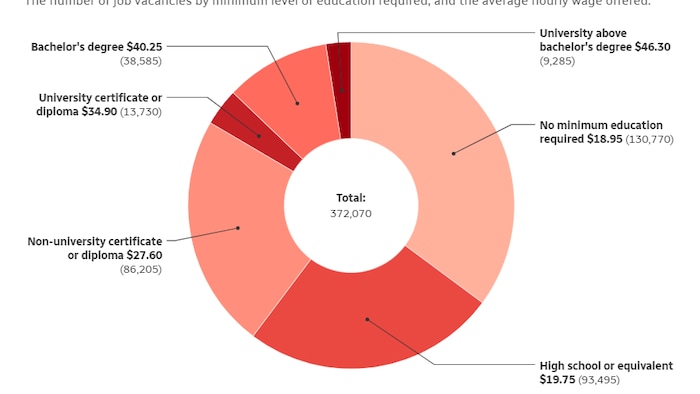
Employers had ’40 years of labour surpluses, they still think workers are a dime a dozen,’ says economist
The vast majority of workers in Ontario haven’t experienced anything quite like it their entire working lives: a labour market tilted in their favour.
Statistics (new window) show unemployment running as low as it’s ever been, record-high job vacancy numbers and unprecedented labour force participation rates.
The labour market is the tightest it’s been in half a century, and it’s not unique to Ontario,
says economist Armine Yalnizyan. It’s happening all through the global north, wherever there was a baby boom after the Second World War.
There’s a traffic jam of employers looking to hire,
says Brendon Bernard, senior economist at Indeed, a job-search website.
This profound shift in the job market has implications for just about everybody, whether you’re an ordinary worker, an employer, a political leader, or someone waiting to get care in a hospital or service in a restaurant.
It could bring about significant changes in the world of work — from recruitment tactics to workplace culture to salaries — but that largely depends on how governments and employers respond.

The latest survey by Statistics Canada, for the third quarter of 2022, found 372,000 job vacancies in Ontario.
PHOTO: SOURCE: STATISTICS CANADA/CBC NEWS
Premier Doug Ford spoke of endless employment opportunities
in Ontario during a news conference in Brampton last month.
You could walk down every street in this province and find a job in every single sector. We need 380,000 people to fill the existing jobs that we have right now,
Ford said.
The most recent figures (new window) from Statistics Canada show 372,000 job vacancies in Ontario during the third quarter of 2022. That’s nearly double the average number of vacancies (195,000) reported during the three years leading up to 2020.
But how good are these jobs? For a fuller picture of what’s really going on in the labour market, take a deeper look into what Statistics Canada found about the current vacancies:
- 60 per cent of the job vacancies in Ontario required no more than high school education, paying on average less than $20 an hour.
- Nearly 200,000 jobs required less than one year of experience.
- More than one-third of the job vacancies were in sales and service.
Still, the overall dynamics of the job market in the province differ substantially from how things were before the COVID-19 pandemic.
Politicians and business leaders sometimes describe what’s happening as a worker shortage, but that framing doesn’t sit well with some observers.
I’m not sure that it’s so much a shortage of workers as a shortage of employers that are willing to pay the wages necessary to get people to work for them,
said Don Wright, former head of the public service in British Columbia, now a fellow with the Public Policy Forum think tank.
Bernard also pushes back against the use of the term worker shortage,
saying it has negative connotations and lacks precision.
I tend to focus more on the balance of strength and power in the labour market when it comes to job seekers versus employers,
Bernard said in an interview.
The way this balance of power has shifted should force employers to shift their mindset, particularly when it comes to compensation, says Yalnizyan, the Atkinson Foundation’s fellow on the future of work.
They’ve had 40 years of labour surpluses and they still think workers are a dime a dozen,
Yalnizyan said in an interview.
The changes mean that temporary foreign workers can now make up 30 per cent of an employer’s workforce in certain sectors, including accommodation and food services, construction, some manufacturing industries, nursing homes and hospitals.
In all other sectors, employers can now hire up to 20 per cent of their staff from the TFW program, double the previous cap of 10 per cent.
Hiring more temporary foreign workers
Employers leapt at the opportunity.
Approvals to fill Ontario jobs with temporary foreign workers more than doubled in the July-September 2022 period compared with the same months in the previous year, according to the most recently available federal statistics (new window).
In sales and service occupations in Ontario, the number of approvals to hire temporary foreign workers tripled.
Wright — who describes himself as a big proponent of healthy levels of immigration
— questions the wisdom of this approach.
This notion of, ‘I’m a business, I can’t get workers to work at the wage I want to pay, therefore the government should fix that problem,’ I just think is really misguided,
Wright said in an interview.

The number of job vacancies by minimum level of education required, and the average hourly wage offered.
PHOTO: SOURCE: STATISTICS CANADA/CBC NEWS
For its part, the Ford government is also looking at other ways to expand Ontario’s labour pool, such as streamlining (new window) accreditation for certain foreign-trained professionals and tradespeople, or expanding (new window) programs designed to help the long-term unemployed get into the workforce.
The labour crunch is undoubtedly most acute in certain sectors of the Ontario economy. You can see that measured by the job vacancy rate: the number of unfilled jobs as a percentage of the employed labour force.
From 2017 through 2019, Ontario’s job vacancy rate (new window) averaged 3.1 per cent across all sectors. Over the past year, it’s averaged 5.3 per cent.
Particularly high job vacancy rates are currently found in restaurants and bars (10.2 per cent), nursing homes (8.5 per cent), truck transportation (8 per cent) and building construction (7.7 per cent), according to Statistics Canada (new window).
If the Bank of Canada gets its way, the labour market will shift back toward employers.
Companies continue to tell us they’re having trouble attracting all the workers they need. That’s a symptom of an overheated economy,
governor Tiff Macklem said Wednesday in a news conference following the Bank of Canada’s announcement of another increase to its benchmark interest rate (new window).
Part of rebalancing demand and supply in the economy is rebalancing the labour market,
said Macklem.
We do expect to see some cooling of the labour market. We expect it to come into better balance.
Mike Crawley (new window) · CBC News
Be the first to comment